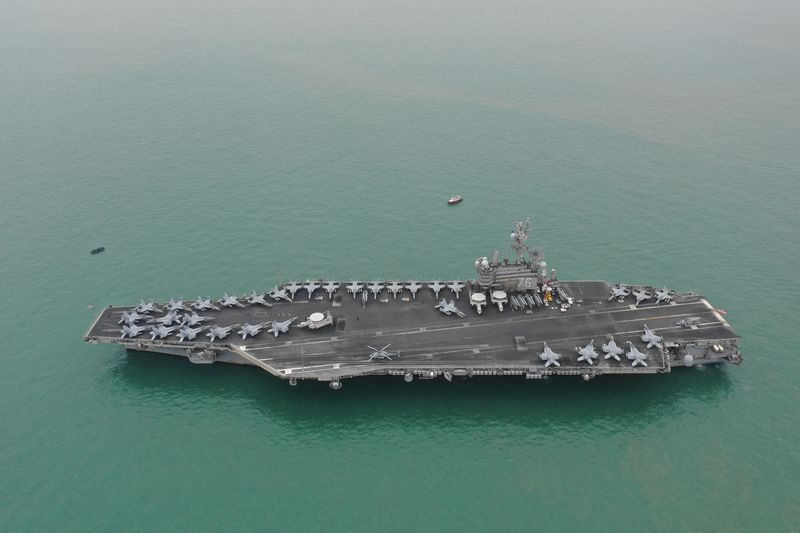By Greg Torode and Idrees Ali
HONG KONG/WASHINGTON (Reuters) - While China's expanded drills surrounding Taiwan have marked an unprecedented military and political warning against outside interference over the island, they opened a window to gather intelligence for the United States and its allies.
The four days of intense drills last week - and extended manoeuvres this week - provide an opportunity to scrutinise the missiles China would use to drive off foreign militaries intervening in any future invasion as well as its command, control and communications systems, regional diplomats and security analysts say.
And on the strategic intelligence front, the exercises have given a clue to China's ability to blockade the island as a prelude or alternative to any invasion, showcasing the firing of ballistic missiles over Taiwan for the first time as well as simulated air and sea attacks on ships on its east coast.
While acknowledging ongoing data gathering, two U.S. military officials have cautioned that the drills are unlikely to offer the type of in-depth intelligence opportunity provided by other manoeuvres beyond the headlines.
China is unlikely to display its best tactics and strategies during drills that it knows are being watched closely, said one of the officials, speaking on condition of anonymity.
The officials said that most of the systems and missiles used by China appear to be known to the United States and allies, so it was unclear how much more could be gleaned on their capabilities over the past few weeks.
Singapore-based security analyst Collin Koh said rather than weaponry, the drills offered a prime chance to monitor key Chinese elements - China's reformed Eastern Theatre Command, its Rocket Force and Strategic Support Force - operating together in a fully coordinated and integrated way.
"I fully expect the U.S. to be collecting from a full spectrum - signals, communications and electronic intelligence - it is just a too good opportunity to miss."
"When you collect this kind of data from the other side, it means you can figure out where the vulnerabilities are, and it helps you create your own counter and jamming systems," Koh told Reuters.
SHIPS, SUBMARINES, DRONES
The United States has kept at least four warships east of Taiwan, centred on the USS Reagan aircraft carrier, during the exercises. And while those ships wield a powerful strike threat, they also operate a vast surveillance capability above, across and under vast swathes of ocean.
Reuters confirmed the presence of the ships last week, and they remain around the Philippines Sea east of Taiwan, according to official Twitter (NYSE:TWTR) feeds.
Less visibly, U.S., Japanese and Taiwanese submarines and advanced surveillance aircraft are likely to be involved in the intelligence operation as well, analysts and retired intelligence officers say.
For example, submarines can collect a warship's individual acoustic "signature" - vital data if a conflict is to ever break out.
Online trackers of aircraft and ships have also reported the presence of specialist electromagnetic intelligence gathering assets in the area, including powerful U.S. RC-135S Cobra Ball (NYSE:BALL) aircraft and a missile monitoring ship. Taiwan also launched its locally produced Albatross reconnaissance drones during the Chinese drills, according to video footage reviewed by Reuters.
The U.S. Indo-Pacific Command did not respond to Reuters questions on the deployment of intelligence gathering assets in the area.
The Chinese and Taiwanese defence ministries did not respond to Reuters' questions.
NO ACTIVE ADVERSARY
The two U.S. military officials said it would take time to digest any intelligence harvested.
While the drills appeared to show that Beijing was able to coordinate its military forces from air, land and sea, the exercises could only reveal so much since there wasn't an active adversary, they said.
"Things are easy when you're not being shot at," one of the officials said.
The officers pointed to Russia's actions in Crimea in 2014 and in Syria over the past few years, which allowed the United States to try and understand Moscow's military capabilities. The United States believed that Russian forces would be able to take Kyiv within two to three days, but their estimates were wrong.
So far, the Pentagon has not changed its assessment that China would be not be militarily capable of staging a successful invasion of Taiwan for five years. And the Pentagon's number three official said on Monday that despite Chinese exercises, the United States had not changed its view that China was unlikely to try and militarily seize Taiwan in the next two years.
Trevor Hollingsbee, a former naval intelligence analyst with the British Defence Ministry, said that a key signals intelligence target would be the role of political commissars on ships - an unusual system of Communist Party control compared to Western militaries.
"They will be looking for any evidence that the double-headed command system of employing a political officer on Chinese warships has a detrimental and exploitable effect upon combat efficiency," Hollingsbee told Reuters.
A statement from China's Eastern Theatre Command on Tuesday highlighted precautions. It described early warning and jamming aircraft operating "under a complex electromagnetic environment to refine joint containment and control capabilities."
On another level, however, China's military chiefs might be unafraid of displaying their expertise in conducting such complex, integrated drills, some analysts believe.

"We got to observe and monitor a least a glimpse of how they look at doing that sort of thing," said Carl Schuster, a Hawaii-based military analyst and a former director of operations at the U.S. Pacific Command's joint intelligence centre.
"I think they wanted us to see it...I think they wanted us to know that this is not the PLA ... of even 10 years ago, they wanted us to know how far they had progressed."